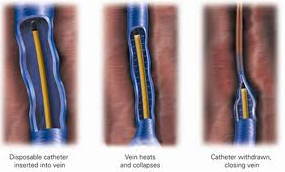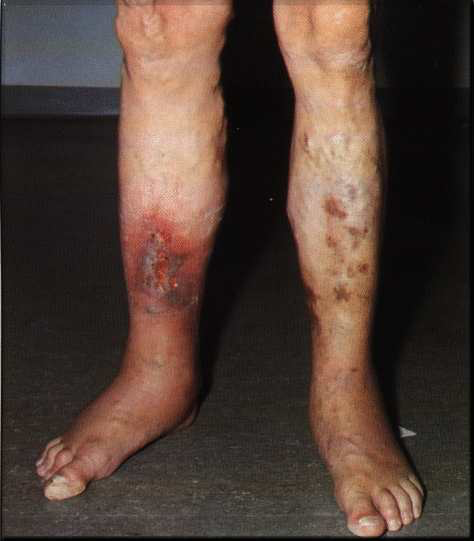Treatments for varicose veins
What are varicose veins?
Varicose veins are the dilated tortuous trunks of the main veins draining the skin of the leg. They are a common problem, occurring in 30-40% of the population. Although they occur equally in men and women, women are more likely to present early for treatment. Varicose veins can develop at any age from the teenage years on, but tend to be more prevalent in the elderly.
A number of factors have been blamed for causing varicose veins: sedentary life style, standing for long periods, obesity and constipation; while squatting is meant to protect you. None of these factors have been proven. It is likely that if you have a family history of varicose veins, your weight, pregnancy or your lifestyle may encourage their development.
What are the symptoms of Varicose Veins?
The symptoms associated with varicose veins are very variable. There is no correlation between the size of the veins and how bad your symptoms are. So one person may have large bulging veins with no symptoms, while another person may have severe symptoms but few visible veins. The symptoms are typically: aching, particularly after standing for long periods, heaviness and tiredness of the legs, restless legs, ankle swelling especially at the end of the day, itching, eczema, skin discolouration and ulceration.
With increasing age, other leg problems such as arthritis of the knee may cause leg pain, which can mimic the pain associated with varicose veins.
If I have varicose veins, will they get worse?
Without treatment, varicose veins do not get better.
Once you have started to develop symptoms such as aching legs, swelling of the ankles and tender veins, it is likely that you will develop more severe symptoms such as eczema, skin discolouration with brown staining, tender thickening of the skin around the ankle and ultimately ulceration.
These symptoms are all skin damage due to the veins that are not working properly.
Most of these symptoms can be reversed by treatment.
Treatments for varicose veins
There are a number of treatment options.
In order to choose the best treatment option for you, I need to see and assess your legs in clinic.
Once assessed, we can discuss the best treatment option for you.
With increasing age, other leg problems such as arthritis of the knee may cause leg pain, which can mimic the pain associated with varicose veins.
Treatments options include:
Endovenous laser therapy & radiofrequency ablation
These methods to treat varicose veins avoid the need for an open surgical procedure.
In all, a thin wire is placed inside the vein through a puncture site in the lower leg.
Under ultrasound control, the lining of the vein is destroyed using heat from the inside.
The damaged vein is converted to a fibrous cord.
The procedure is usually performed under local anaesthetic.
The heating element burns the vein from the inside and the vein shuts down.

Sapheon closure device (glue)
New alternative treatments such as mechanochemical ablation (Clarivein) avoid the need for local anaesthetic as these are relatively painless and only require a single injection at the entry site.
Another relatively painless technique is the Sapheon closure device which uses glue to seal the vein.
With increasing age, other leg problems such as arthritis of the knee may cause leg pain, which can mimic the pain associated with varicose veins.
Foam sclerotherapy
This is a relatively painless out patient procedure. It is not suitable for all varicose veins but it is an excellent option for recurrent veins and for isolated varicosities. It involves the injection of a foam solution in to the vein. This causes the walls of the vein to stick together. Over time the collapsed vein turns into scar tissue.
The procedure takes approximately 30 minutes. You may need more than one treatment session but I should be able to advise you when I assess your leg.
Foam sclerotherapy can be very successful for treating varicose veins with 80-90% of individuals getting a good response.
Surgical treatment
The aim of open surgical treatment is to disconnect the junction where the main varicose vein joins the deep vein. Once the junction is tied off, the varicose vein trunk is stripped out. The main junction at the groin is tied off through a small cut at the groin and the vein is stripped out through a second small cut at the knee. The vein at the back of the knee is dealt with in a similar manner through a small incision. Local varicosities are then removed through multiple 2- to 3-mm stab cuts along the course of the vein.
Varicose vein surgery is associated with a high incidence of minor surgical complications: extensive bruising, wound infections, damage to small nerves responsible for feeling in the skin and the lymphatic vessels. There is a 5% incidence of recurrence. It usually takes approximately 2 weeks to recover.
NICE guidelines recommend endovenous treatments should be considered before open surgery is offered. I rarely offer open surgery as I believe the alternatives are better.
Conservative management – compression stockings
The symptoms associated with varicose veins are due to a raised blood pressure within the vein. Compression stockings counteract this pressure effect, and can give excellent symptom control. Stockings are designed to be tighter at the ankle than at the calf, this helps the veins to work better and relieve the discomfort in the leg. Most people find the below knee stockings more comfortable than full leg stockings. Full leg stockings tend to roll down without a belt and suspenders to hold them up, so they often end up in the bottom drawer.
As a result of the increased awareness of the risks of developing a deep vein thrombosis while flying, below knee support socks are now widely available and promoted as “flight socks”. They are available in a wide range of colours and “breathable” materials. However, to achieve symptom control, they do need to be worn all day every day. Class I stockings should give good symptom control for most people with varicose veins. Stronger stockings (Class 2) are only necessary if you have developed skin problems or you have had an ulcer which has healed. A trail of compression socks can be useful to see if they help your symptoms. If they don’t, it is likely you have another problem causing your leg symptoms.
What happens if you do not have treatment for your varicose veins?
Initially, when varicose veins develop, they do not cause symptoms. However, over time, they can give symptoms – aching legs, tired and heavy legs, itching, local tenderness, and skin discolouration. About 1 in 20 people will develop symptoms. As the disease progresses, you may get complications of varicose veins including eczema and ulceration. Occasionally varicose veins will bleed.
For the full range of stockings available, see: www.daylong.co.uk
Aching legs
Tired aching legs are a common symptom of varicose veins and venous disease. As you stand, the pressure in the veins of the legs goes up. If your veins do not work properly, you may get fluid retention in the legs. This causes the aching sensation. Your legs feel tired and heavy. This sensation can be relieved by elevating the legs. It may also be relieved by wearing compression stockings. If the underlying cause is superficial venous disease or varicose veins, treatment can give symptomatic relief.
Leg ulcers
A leg ulcer is a break in the skin that has been present for more than 2 weeks. Leg ulcers can occur following trauma or infection. They may develop in a patch of skin irritated by eczema. Usually healing can be expected within a couple of weeks but if there is an underlying problem such as varicose veins, healing is delayed.
The majority of leg ulcers are due to venous disease, either varicose veins or secondary to problems within the deep veins of the leg (following deep vein thrombosis (DVT)). Leg ulcers can occur at all ages although they are more common in the elderly.
Most venous ulcers will heal with an appropriate compression bandage regime. Prior to applying compression bandages, the blood supply must be assessed with a Doppler assessment. Unfortunately, 1/3 of venous ulcers will recur with compression treatment alone. Therefore, it is important to assess the veins of the leg with duplex ultrasound and to treat any varicose veins to reduce the chance of the ulcer coming back.
Endovenous therapies are ideal for elderly patients as they do not require a general anaesthetic

Assessment
If you have varicose veins, you need to be assessed with ultrasound to determine the most appropriate method of treatment for you.
Case Study – Mrs. TC
T.C. is a 43 year old accountant. She came to see me to discuss her recurrent varicose veins. She had developed varicose veins in her teens. She had had surgery in the 1990’s with a high tie and strip to both legs. This was the standard operation at the time. Her veins came back and she had further groin surgery with limited success. She also had some injection treatment for some spider veins but these came back almost immediately.
She came to my clinic on the recommendation of a friend. Her legs were beginning to ache and she was unhappy with the appearance.
I examined her legs in clinic using ultrasound. With ultrasound, I am able to work out the anatomy of the problem and make a plan to treat the cause of the recurrent varicose veins. Although TC had had previous surgery, she still had a large leaking vein in the thigh of her right leg. This was connected to the deeper veins through a perforator. The vein in her thigh was filling the varicose veins in her calf. On the left hand side, she had a large vein arising from the groin filling large veins down the lateral side of her leg.
We discussed the options. She didn’t want an anaesthetic and I reassured her this was not necessary. We agreed a treatment plan.
I treated the big vein in her right leg with mechanochemical ablation, a technique that is almost painless, it feels a bit like having an electric toothbrush pulled through your leg. I treated the varicose veins in her calf with foam sclerotherapy. She was delighted with the result. Her leg no longer ached and the veins had all gone.
She came back for treatment to her left leg. I injected these veins with foam sclerotherapy. Once again, she had an excellent result. Once the main veins have been treated and the back pressure relieved, I was able to treat her spider veins with microsclerotherapy.